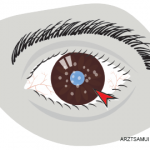- A thorough history and exam, with a focus on extraocular signs and symptoms.
- A chest radiograph given the prevalence of sarcoidosis, and the ability to identify other common culprits, such as granulomatosis with polyangiitis (GPA) and tuberculosis.
- Syphilis testing, because it’s easy to treat.
Of note, an isolated unilateral episode of uveitis may not require an extensive evaluation. “Obtaining a chest radiograph and syphilis testing is quick and easy, but additional evaluation and referral to a rheumatologist may not be necessary [because] the uveitis episode may be the first and last occurrence,” Dr. Kolfenbach clarified.
He also touched on anterior scleritis, and the far rarer and vision-threatening posterior scleritis, which comprises only 2% of cases but is harder to diagnose.4 He offered the following pieces of wisdom: “Nodular scleritis confers a high risk of connective tissue disease and conversion to necrotizing disease. Seropositive rheumatoid arthritis rarely presents with scleritis, but GPA may.”
Dr. Kolfenbach reminded us that “in patients with autoimmune disease, not every ‘exacerbation’ is from the underlying rheumatic illness.” Vigilance for ocular infection must remain high, especially in the immunosuppressed patient, [because] misdiagnosis can have vision-threatening consequences.
A Common Language
For the second half of the presentation, Dr. Palestine stressed the importance of finding a common language to describe ocular inflammation; this is imperative to defining therapeutic success and failure. Rheumatologists and ophthalmologists don’t describe eye issues in the same way. What’s more, ophthalmologists may also use variable descriptions because ocular immunology specialists are few and far between.
“Redness is subjective,” he reminded us. “Classification criteria were just recently developed for uveitis, but 50% of cases still don’t fit within these criteria. We have a long way to go regarding a uniform understanding of these diseases.”5
Vigilance for ocular infection must remain high, especially in the immunosuppressed patient because misdiagnosis can have vision-threatening consequences.
The Ophthalmologist’s Point of View
Dr. Palestine offered valuable insight from the perspective of the co-managing ophthalmologist. “A search for a systemic disease association is always worthwhile given the therapeutic implications, but don’t be disappointed. We often find nothing,” he said. He recommended defining the location, course and progression of eye disease, and then framing the evaluation around history, clinical findings and imaging. “I recommend a targeted workup to avoid costly false positives. Atypical clinical findings or treatment response would justify more extensive testing.”



